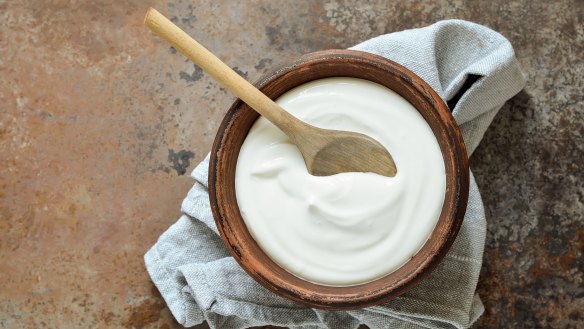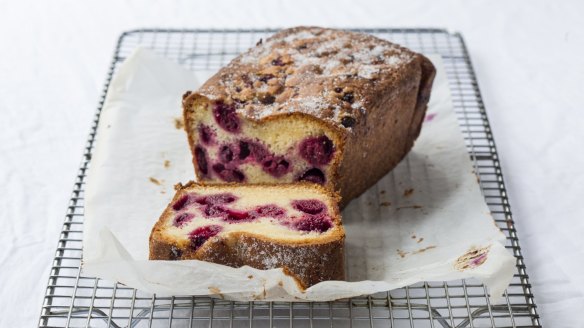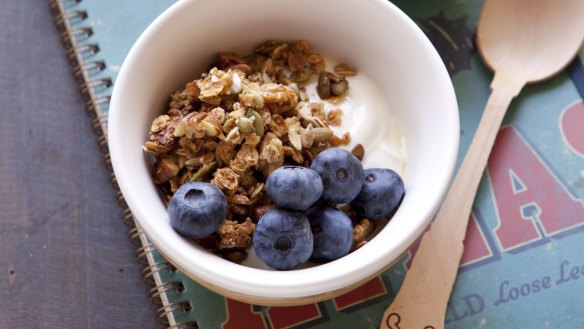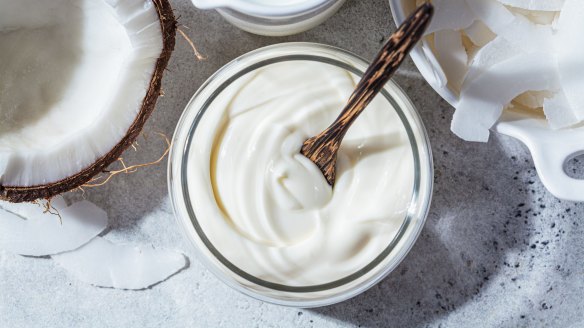Greek, natural or coconut? How to choose the healthiest yoghurt

- Recipe collection: 70 sweet and savoury yoghurt recipes
- Why quark is a healthy high-protein health food
You could be forgiven for feeling a tad confused when you are standing in front of the yoghurt section in the supermarket.
Greek, natural, fruit, plant based, coconut, protein – the list is endless. Even as a nutrition professional it takes some time studying the tiny nutrition panels and ingredient lists to differentiate products.
So, in an attempt to make navigating the yoghurt aisle a little easier, here is a summary of the main varieties of yoghurt and the pros and cons of each.

Greek yoghurt
Thicker, and with a much stronger taste than natural yoghurt, Greek yoghurt is an extremely nutritious option. Slightly different processing sees Greek yoghurt strained and fermented with live bacterial cultures, which concentrates the protein, while also reducing the natural lactose content (naturally occurring sugar found in milk). Nutritionally this results in a yoghurt that has more protein and less natural sugar, although some of the key nutrients including calcium are also reduced as a result of this processing. Full fat Greek yoghurt contains close to 10 per cent fat, as opposed to reduced and low-fat varieties, so if one of your goals is to reduce your intake of saturated fat, opt for the lower fat varieties of Greek yoghurt. Greek yoghurt's naturally tangy flavour makes it an excellent alternative to cream in savoury dishes, or to sour cream as a side to Mexican dishes. It also works well as a thickener in baked goods such as banana bread, although in these instances it's best to choose the full fat version so it retains flavour and ability to blend with the base of the cake or muffin.
Greek-style yoghurt
Just to make things a little more confusing, you can also find "Greek-style" yoghurt in supermarkets. Unlike traditional Greek yoghurt, Greek style does not go through the time-consuming process of straining. Rather, it is processed with a range of thickeners and gums to give it a texture that's similar to Greek yoghurt but is more stable and lasts longer.In general it's better to avoid highly processed products, which means if you're shopping in the dairy aisle, seek out the real thing rather than the "Greek-style" alternative.

Natural yoghurt
Natural yoghurt is made with a simple mix of cow's milk and cultures, which are then fermented and thickened. Unlike Greek yoghurt, it is not strained. Natural yoghurt has no added flavours or sugars and can also be found in full fat or low-fat varieties. With 0-4 per cent fat, five grams of natural sugars and almost 200 milligrams of calcium per 100 grams, natural yoghurt is an excellent option nutritionally to serve with fresh fruit or as a creamy substitute for cream, sour cream or milk in baking. It is also the best choice for those wanting the nutritional benefits of yoghurt minus the extra sugars or protein found in higher protein Greek and protein yoghurts.
Protein yoghurt
"Protein" yoghurt is extremely popular in supermarkets. It's generally a concentrated Greek yoghurt that is cleverly marketed to appeal to an active consumer. Protein-rich yoghurts contain 10-20 grams per 100 grams and often contain added sugars – a significant carbohydrate load – or low-energy natural sweeteners to give them a low-sugar, high-protein nutritional profile. The latter are a healthy option for adults, however too high in protein for children.

Fruit yoghurt
Greek and natural yoghurts both come in fruit flavours. The key is to opt for sweeter varieties that have as little added sugars as possible. A quick scan of an ingredient list will help to determine if anything other than milk, cultures and fresh fruit can be found in your yoghurt. Some higher protein fruit yoghurts may also contain sweeteners to help bring the overall sugar content of the yoghurt down. Where possible seek out natural sweeteners rather than artificial sweeteners, which are identified with 950 numbers on the packaging.
Icelandic yoghurt
"Skyr" is an Icelandic yoghurt variety only recently introduced to Australia. It's made in a similar way to traditional Greek yoghurt but it contains more milk and more protein as a result of extra straining. While plain Icelandic style yoghurt is extremely nutritious, most supermarket varieties are sweetened to make them more palatable and as such are a little high in sugar compared to plain varieties of yoghurt.

Coconut yoghurt
This variety of yoghurt has become increasingly popular with people on plant-based diets. It's made using the milk squeezed from the flesh of coconuts, which then has live cultures added to ferment the milk. With minimal protein or calcium, and significantly more fat than dairy-based yoghurt, coconut yoghurt is very different nutritionally to regular yoghurt. It should be considered more of a "dessert" and eaten in moderation rather than considered an everyday food.
Plant yoghurt
More plant-based yoghurts made from oats, nuts and soy are popping up in supermarkets. Due to their different ingredients, these plant blends vary greatly in their nutritional profiles, but they all tend to be much lower in protein than dairy-based yoghurts (0-3 per cent compared to 5-20 per cent for dairy). They also generally contain added sugars to improve flavour, and they often do not contain important key nutrients such as calcium, which you usually find in natural yoghurt. So if you prefer plant-based eating, or need to avoid dairy, always check the ingredients list of the plant-based yoghurts in the supermarket and opt for one that contains few added sugars.
Susie Burrell is a nutritionist and dietitian.
The best recipes from Australia's leading chefs straight to your inbox.
Sign up